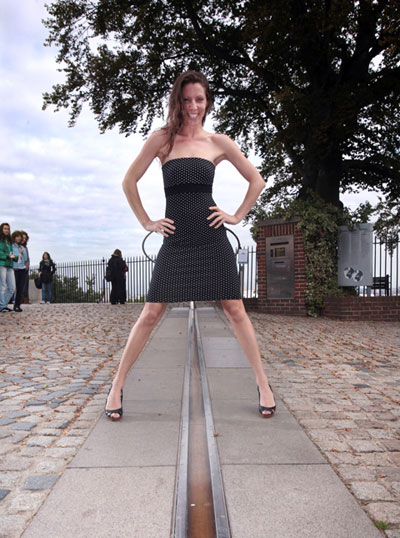You Too Can Step Over The Line
by Joan Sisley, London Press Service

Ivana Lawrance from Holland straddles the meridian line at the Greenwich Observatory, London. Photo by EdRobisonPhotography.com. |
It's simply a line across the cobbles but the prime meridian line at the Royal Observatory in London is one of the most celebrated and important markers on the globe, for it is the centre of world time - every place on Earth is measured in terms of its distance east or west from it.
In 2009, the International Year of Astronomy, the famed line where Greenwich Mean Time is set, celebrated 125 years of existence. Visitors from across the world - the observatory now welcomes more than two million every year - enjoy being pictured straddling the line, one foot in the east and the other in the west, as a high-point memento of their trip to the UK.
The Greenwich observatory, recognised as one of the most important historic scientific sites in the world has, indeed, a global audience. As well as the hundreds of thousands of young Chinese, Japanese, Indian, North and South American and European visitors wanting to be photographed on the line, it has appealed to the celebrated.
People such as Russia's Vladimir Putin and US President Jimmy Carter have been pictured there and scores of showbusiness stars (such as Tom Hanks), as well as many visiting overseas dignitaries, including the normally low-profile Chinese delegations, have wanted to have one foot in the orient and the occident at the same time.
The north-south line is quite simply, as the centre of world time, the starting point of each new day, each new year and each millennium. It is longitude zero and divides the eastern and western hemispheres of the planet in the same way the equator divides the northern and southern hemispheres.
The prime meridian is defined by the position of the large (transit circle) telescope sited in the observatory's Meridian Building built by George Biddell Airy, the seventh Astronomer Royal in 1850. Amazingly simple, it is the cross-hairs in the eyepiece of the transit circle telescope that define longitude zero.
The Greenwich meridian was chosen to be the prime meridian of the world in 1884 after 41 delegates from 25 nations met in the United States capital for an international conference and voted overwhelmingly for the English location. France, who wanted it sited in Paris, abstained from the vote.
The victory must have been helped by the fact that at that time 72 per cent of the world's commerce depended on sea charts that used Greenwich as prime meridian, and that the US had already chosen it as the basis for its own national time-zone system.
Since the late 19th century, the Greenwich prime meridian had served as the coordinate base for the calculation of Greenwich Mean Time (GMT). Before then, almost every town in the world kept its own local time, with no national or international standards to set the measurement of time or to say when the day would begin or end or what the length of an hour might actually be. Making an international time standard finally became imperative.
The observatory at Greenwich, now linked with the National Maritime Museum in Greenwich, has a great history in astronomy and in the last decade has seen a vast change from a rather staid establishment into a lively and fascinating place to visit.
Sited in a royal park with a stunning view over London on one side, there are two sites side by side, the latest being opened in 2007. But both old and new present a visually pleasing and seamless blending of buildings.
They span the centuries from the gracious Wren-designed red-brick 17th-century Flamsteed House (home to past astronomers royal) to the modernistic, curved bronze construction that is atop the planetarium.
It was granted World Heritage Site status in 1997 and the attractions about time, astronomy and science, now match those of a modern museum. They include an avant-garde planetarium, telescopes including the transit circle, a historic collection of clocks including the renowned Harrison clock, the only public camera obscura and much more. A chunk of meteorite there is reckoned to be billions of years old.
The emphasis nowadays is on inter-acting with a wider public and to develop this theme the observatory appointed in 2008 the first public astronomer. Dr Marek Kukula is a renowned authority on distant galaxies, quasars and super-massive black holes. He spent nine years at Nasa and with the Hubble telescope; his background in education includes being first a research fellow and then an advanced fellow at Edinburgh University.
His passion for his subject and his enthusiasm in communication are helping to bring a new dimension to the work at Greenwich. Throughout the year the observatory run a number of programmes and exhibitions, and for the birthday of the meridian line it held a week-long series of lectures and other events.
No doubt the tide of visitors that flow in will continue to appreciate the historic and unique scientific sights to be seen. But all at the observatory agree that, particularly for young visitors, the one thing for which they make a bee-line, and what they most want to do, is to see and cross that line.
Royal Greenwich
© 2010 offtolondon.com All rights reserved.
Contact Us
|
|